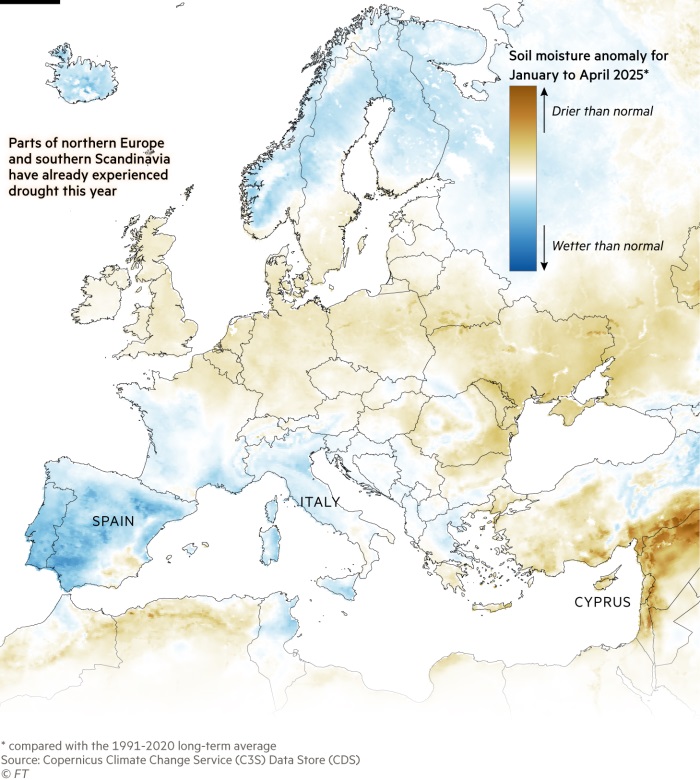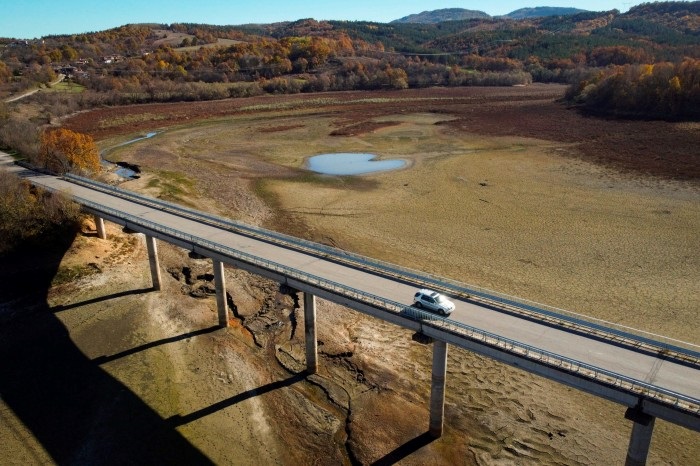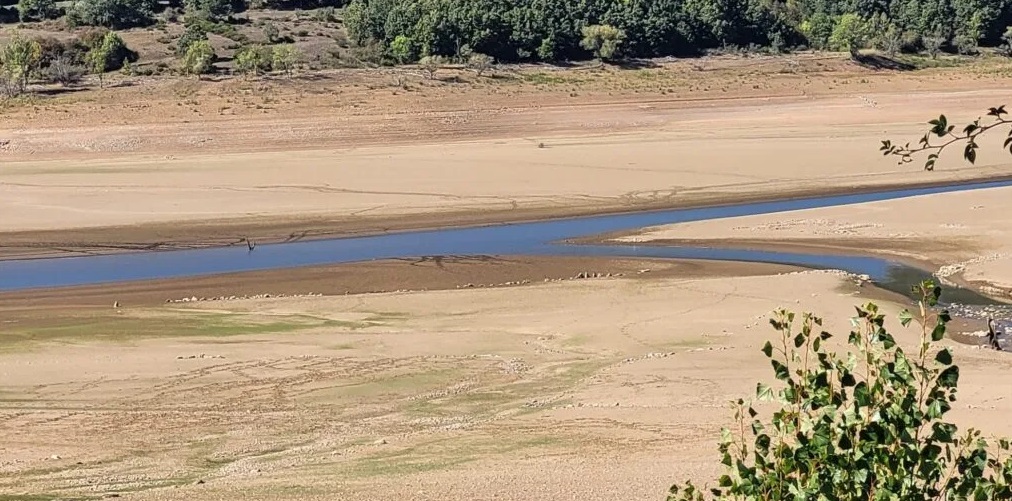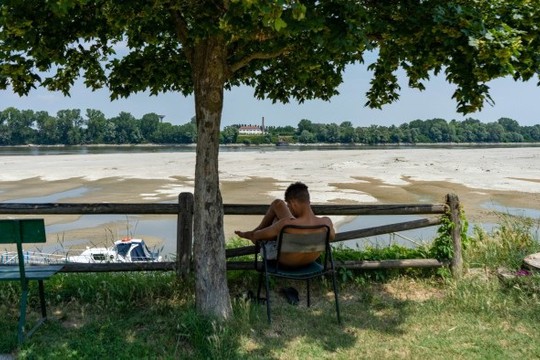Dried riverbed in Calto, Italy. The European Commission’s plan to set a water efficiency target signals concern about the bloc’s dwindling groundwater reserves.
Photo: Bloomberg
Brussels will urge EU countries to cut water use by at least 10 per cent by 2030 as the bloc faces longer and more widespread droughts.The plan, due to be presented next month and seen by the Financial Times, marks the first time the European Commission will set a target for water efficiency and signals concern about the EU’s dwindling groundwater reserves.
“We need to think about how we need to use water more efficiently,” EU environment commissioner Jessika Roswall told the Financial Times. “When we have a shower, we need to think about it.”
Summertime mandates of limiting water consumption, including bans on filling up swimming pools, have become common in southern Europe.
Haris Sachinis, the chief executive of Eydap, the largest water company in Greece, has warned repeatedly that if no action is taken immediately, Athens could run out of water in the next two years, especially if the current hydrological conditions persist.
In Cyprus, 2025 “marks our third consecutive drought year and represents the eighth worst period for water reserves” in 50 years, according to agriculture minister Maria Panayiotou.
Even in Roswall’s native Sweden, one of Europe’s northernmost countries, watering gardens with a hose is now banned in some areas. In France and Spain, fights have broken out between farmers and environmentalists over water rights and plans to build dams in recent years.
The water plan will set out how the EU can become more resilient in the face of water stress — when demand outstrips supply — and aims to push member states to invest more in pipes, pumps and treatment plants.

About 25 per cent of water in the EU is lost through leaks, according to the water industry body EarEau. But the percentage is much higher in some countries such as Bulgaria, which loses about 60 per cent of water through leaky pipes each year.
The commission estimates that €23bn is needed annually to fund water infrastructure properly, officials involved in drafting the water plan have said. The European Investment Bank will also put together a programme of €15bn of loans and guarantees to finance water infrastructure from 2025 to 2027, the document said.
The plan said that only 2.4 per cent of water is reused each year in the EU — a number that should increase. The draft may be subject to change before its publication.
 Bulgaria loses about 60 per cent of water through leaky pipes each year. Yovkovtsi dam in November last year.
Bulgaria loses about 60 per cent of water through leaky pipes each year. Yovkovtsi dam in November last year.
Photo: AFP
The 10 per cent savings target will not be mandatory, with the commission encouraging member states to set their own national goals and gather more data — often lacking in the water sector. Some particularly water stressed countries, such as Spain, have already set their own water efficiency targets.
But in a climate assessment published on Wednesday, the commission said that only a “limited number” of member states had considered water resilience measures.
The EU plan comes after the commission last year warned about growing competition for water resources, including the “potential risk of conflicts within and among the member states”.
Roswall said that member states needed to work together on water-related issues: “When it comes to water it doesn’t follow national boundaries.”
Banks and financial institutions are also increasingly recognising environmental factors such as water shortages as a critical threat to business. The European Central Bank said last week that “surface water scarcity alone puts almost 15 per cent of the euro area’s economic output at risk”.
Despite conditions in southern Europe being less dire than last year thanks to heavy rain during the spring filling reservoirs, officials and businesses are concerned about short-term water shortages.
 Spain classified as a country with high water stress.
Spain classified as a country with high water stress.
Photo: Waternews Europe
Aragon in northeastern Spain is a land of cornfields, peach farms and cherry orchards, where water was a precious commodity even before the advent of climate change. Now, as the threat of drought increases, the farmers of Aragon could find themselves competing with a powerful and extremely thirsty new neighbor: Big Tech! – POLITICO stresses.
U.S. giants Microsoft and Amazon are investing billions to snatch up land in the increasingly water-stressed territory with the aim of building data centers, which typically use many millions of liters of water a year.
The Spanish and regional governments are ecstatic. The country’s former digital minister celebrated Amazon’s decision to move in last year, boasting that Spain is “at the forefront of technology innovation and Artificial Intelligence in Europe.” It goes hand-in-hand with the European Union’s push to build more data centers on home soil: The European Commission wants to triple the EU’s data center capacity over the next five to seven years.
But the locals aren’t buying what Big Tech is peddling.
While the likes of Amazon promise more than €15 billion of investment, jobs, partnerships with local schools, community education programs, water infrastructure updates and “sustainability initiatives,” grassroots groups are springing up, wary of tech giants muscling in on their water resources.
“In the end the farmer never wins,” said Chechu Sánchez, an Aragonese farmer speaking at an event on data centers in Zaragoza, Aragon’s capital. “Whenever there is plunder by foreign capital, the farmer, the people of the municipalities — we never win, we don’t benefit at all.”
This battle for water is playing out across Europe, from Ireland to France, complicating the bloc’s A.I. ambitions and posing a dilemma for EU policymakers.
Much has been written about A.I.’s energy demand and carbon footprint. But running a data center is also extremely thirsty work. In 2024, Europe’s data center industry consumed about 62 million cubic meters of water, which is equivalent to about 24,000 Olympic swimming pools.
As the sector grows, consumption is expected to reach 90 million cubic meters by 2030, according to the water sector lobby Water Europe.
That’s because data centers generate a lot of heat and need to be cooled down constantly. Water is “key basically to these data centers, whether it’s for AI or whether it is for every time we send an email message or WhatsApp message, or every time we do a search on the Internet,” said Kevin Grecksch, a lecturer in water science at the University of Oxford.
Europe is facing increasingly frequent droughts, which are destroying soil health, threatening crop yields, and complicating the transport of goods by river.
Big Tech, meanwhile, has seen its water use soar. Microsoft’s water consumption nearly doubled in the three years from 2020 to 2023, nearing 8 million cubic meters, most of that going to cooling data centers. Amazon does not disclose its total water footprint.
But such environmental concerns aren’t slowing the global AI arms race. EU governments are determined to roll out more data centers across the continent as they attempt to catch up with AI leaders the U.S. and China.
One internal document obtained by POLITICO summarizes countries’ proposed strategies to promote the development of “sustainable, geographically balanced infrastructure optimized for AI and data processing within the EU.”
A draft of the European Commission’s upcoming Water Resilience Strategy, also obtained by POLITICO, notes that strategic sectors for the clean and digital transitions, including data centers, are consuming large amounts of water, and should be pressed to achieve maximum water savings in the future.
Some also argue that prioritizing resource allocation to tech innovations like AI is essential because these technologies will help European companies be less resource intensive in the future.
Microsoft believes AI will help manage water and energy efficiency, providing net improvements to both, the company’s global sustainability policy lead Michelle Patron told POLITICO. In Spain, where Microsoft has four data centers, the company is also using AI. “to look at the local utilities, the pipe [infrastructure] to identify where there are leaks, to be able to enable less water loss,” she said.
Amazon’s cloud provider service, Amazon Web Services (AWS) has the same target, while Google has pledged to “replenish 120 percent of the freshwater volume we consume, on average, across our offices and data centers by 2030.”
Activist Gómez claims that’s all ‘greenwashing’.
“Amazon, they made a huge campaign [saying] we are going to be water positive, we are going to be so efficient and so on,” she said. “But at the same time, they are asking for 48 percent more water in Spain to expand their data centers.”
Oxford University’s Grecksch says it’s “completely wrong” and “a misunderstanding of the basic science [to say] that you can replenish more water that you took out, that’s just physically impossible.”
read more in our Telegram-channel https://t.me/The_International_Affairs

 10:04 31.05.2025 •
10:04 31.05.2025 •























